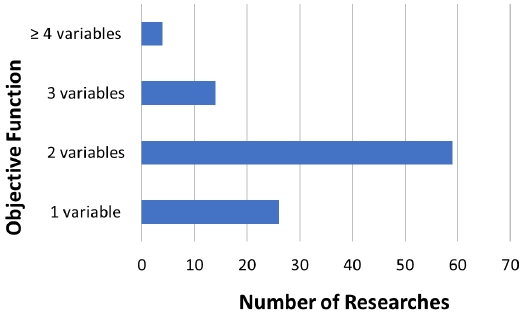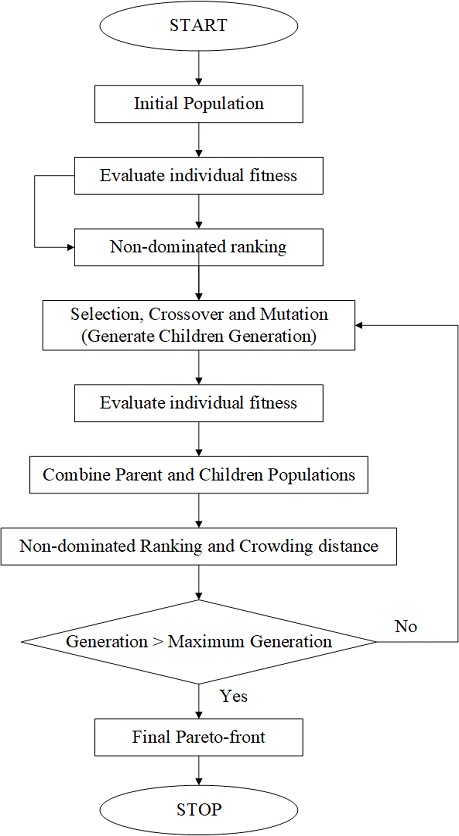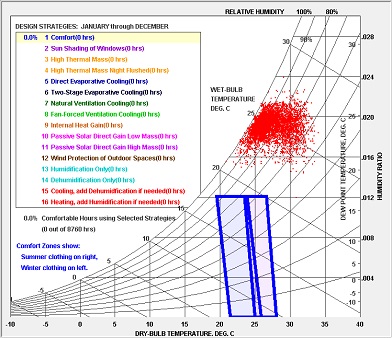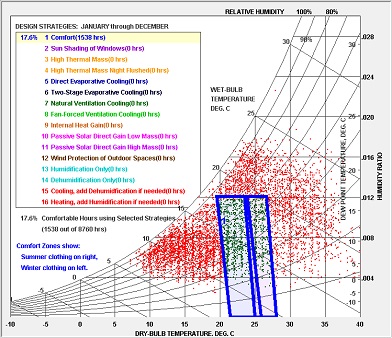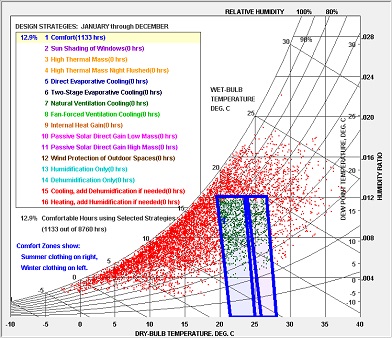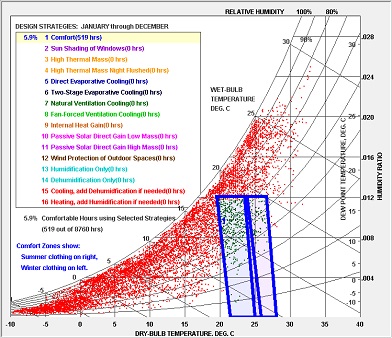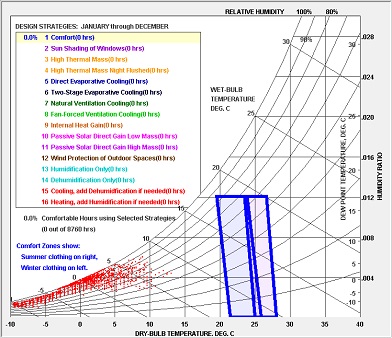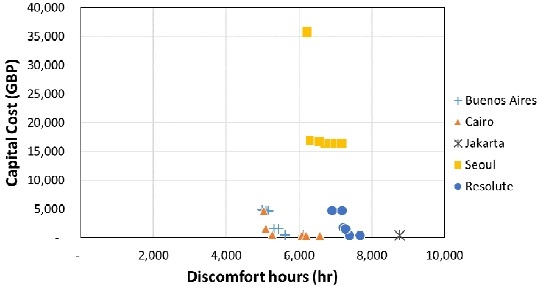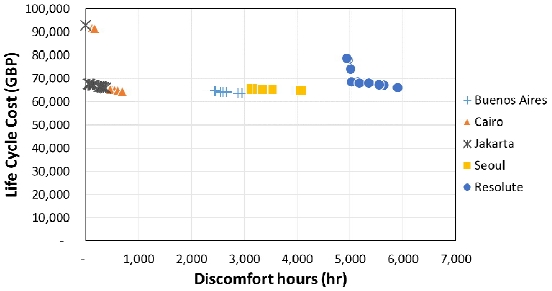
Performance Optimization of a Simplified Passive Design Space in Diversified Climatic Contexts
ⓒ 2020. KIEAE all rights reserved.
Abstract
Building design optimization could be performed in various ways. In most cases, potential design alternatives are evaluated against multi-criteria performance indicators through iterative create-test processes. Especially for the early design stage, optimum passive design of a building tends to be more critical and needs to be investigated rigorously. This study focuses on building passive design optimization in different global regions considering their climatic characteristics. Site location, building orientation, wall construction, and glazing assemblies are considered to be primary passive design variables. Objective functions for optimization include occupancy comfort, capital cost, and life-cycle cost.
By utilizing DesignBuilder’s genetic-algorithm-based optimization tool, a single-room type highly simplified spatial unit virtually being located in 5 different global regions (Jakarta, Cairo, Buenos Aires, Seoul, and Resolute) is evaluated and optimized against two essential design criteria.
It is turned out that passive building design in different climatic contexts may lead to a different set of strategies to minimize occupant’s discomfort and life-cycle cost. The research outcome shows that the lowest solar transmission glazing assembly, which is critical for optimum passive design strategy in cooling-dominated regions may not function properly in the locations where tropical hot-humid weather prevail.
Keywords:
Passive Design, Simplified Spatial Unit, Climatic Context, Comfort, Life Cycle Cost1. Introduction
1.1. Research background
Building performance evaluation is a critical step to evaluate various design options for obtaining satisfying design outcome fulfilling multiple requirements. Building performance could be predicted during the design phase and verified in actual operation. Especially in the early design stage, the design could be optimized through various simulation packages such as TRNSYS, EnergyPlus and ESP-r. Design optimization tools are also available such as GenOpt, JEPlus, BeOpt and MultiOpt. Some of those tools are embedded in building performance simulators.
Several precedent studies attempted building design optimizations for best performance. Fig. 1. illustrates some studies that dealt with building design optimization classified into their number of objective function variables adopted for optimization. Two-variables optimization (mostly energy and cost) marks the highest frequency among 59 examined studies[1][2]. These are for either retrofitting existing buildings or early-design of new buildings.
Hamed S.G., et al. (2018) investigated a multi-objective optimization model for four different climate regions in Iran to improve building design specifications. This study adopted two objective function variables for optimization, including total life-cycle cost (investment, NPV based maintenance and operation cost) and thermal energy loads (heating and cooling loads). Envelope assembly and HVAC system options are significant design variables in this research[3]. Raphael Wu, et al. (2017) also developed a multi-objective optimization scheme for building retrofit in Switzerland through which annual maintenance cost and life cycle GHG (Green House Gas) emission were evaluated[4]. Guo, et al. (2018), attempted residential building passive design optimization and suggested a framework for optimizing a building design considering both energy demand and thermal comfort at the same time[5]. Cho, et al. (2018) investigated apartment-building’s energy performance in relation with different locations and orientations in Korea. It turned out to be that the vertically middle-part apartment units consume the least heating energy[6]. Park, et. al. (2020) focused on window passive design in office buildings for three different climate conditions in Korea. Regarding this work, external shade and daylight control could save up to 6% of energy consumption[7]. As a particular case, Schito, et al. (2018) explored a museum design optimization based on energy demand, thermal comfort and artwork lifetime influenced by varying HVAC system options[8]. Kang, et al. (2020) analyzed passive design elements in a hospital by considering daylight factor and energy saving[9].
There are also several works targeting algorithm improvement to support multi-objective optimization such as OBEM, NSDA-II algorithm and ant colony optimization algorithm for mixed variables (ACOMV)[10–12].
Several key points were identified in relation to building design optimization including building types, design objectives variables and alternative evaluation algorithms. After reviewing precedent studies, the necessity of a more generalized multi-criteria design optimization framework for supporting various building types in different global locations caught our attention.
2. Materials and methods
Considering the shortcomings due to limited design optimization target variables and heterogeneous building types and configurations, we propose a generic passive design space with a typical single-room configuration located in different global regions and test it against occupant’s comfort and cost aspects. A highly simplified generic space is defined with only passive elements constituting pure physical structure nullifying any additional system installations (i.e., HVAC or lighting system). This generic space could represent a bay or a unit of an office building located in different climatic regions.
A single room type test space was modeled using DesignBuilder v4.7.0.027 with the dimension of 4.5m × 4.5m × 3m and it has a glazed area only on one side wall. The window-to-wall ratio (WWR) is set to be 0.50, as it is visualized in Fig. 2 (adiabatic and non-adiabatic surface configurations). The Base weather profile for this work is linked to Incheon, South Korea.
2.1. Adiabatic surface modeling
A typical office unit has at least single wall exposure to outside environment, therefore, no notable heat is transferred through other surfaces such as sidewalls, roof and floor. Since consecutive neighboring office units do not trigger temperature differences associated with internal walls, ceilings, and floors, heat transfer could be nullified through adopting adiabatic surfaces for modeling this condition. For the comparison purpose, both adiabatic and non-adiabatic surface configurations of the test space were evaluated under the same simulation conditions.
2.2. Performance assessment simulation and optimization
A series of performance evaluation simulations and passive design optimizations are performed using DesignBuilder v4.7.0.027. Optimization is carried out for minimization of occupant’s discomfort and life-cycle cost.
DesignBuilder only allows two objective variables, ten design input variables as well as user-input-based constraints that can be assigned to different variables for optimization. Building design optimization is carried out based on two stages. Initial optimization considers only passive design elements without HVAC and lighting system installations while the extended optimization includes HVAC and lighting systems. Table 1. and Table 2. show the design variables that are used in the initial and extended optimizations. Further details of walls, glazing and HVAC templates used for optimizations are described in Appendix Table A.1., Table A.2. and Table A.3.
This work also includes different climate zones based on Köppen climate classification[13]. Five different climatic regions being tested are shown in Table 3. Those regions represent diversified climate zones covering North-South Hemisphere and West-East Hemisphere.
2.3. Objective functions
Two objective variables for design optimization are selected for minimizing both discomfort hours (based on ASHRAE 55 Standard) and cost. As for the cost variable, in initial optimization, capital cost (Capex) is calculated, whereas, in extended optimization, life-cycle cost (LCC) is used. Explanations on each optimization objective variable is presented below based on DesignBuilder’s calculation condition and limitation.
Calculation of discomfort level for each design alternative is progressed based on ASHRAE Standard 55-thermal environmental condition for human occupancy. This standard recommends a specific percentage of acceptability and the values of thermal environmental indicators. This comfort model is based on operative temperature which is calculated based on air temperature, mean radiant temperature and air-speed. Insulation clothing is assumed to be 0.5 clo for summer and 1.0 clo for winter[14][15]. The identified comfort zone for each tested region is illustrated as psychrometric chart in the following section.
Capital cost includes construction, material, glazing and shading device costs. Capital cost data is tightly associated with the building geometry which represents components and assembly[16]. Life Cycle Cost is the variable which combines both installation and operational cost for buildings. Considering these differences, we adopted capital cost calculation in initial (passive) optimization and life-cycle cost calculation in extended(passive+active) optimization.
Genetic algorithm (GA) is an AI technique utilized in the DesignBuilder v4.7.0.027 building design optimization process. This GA is based on non-dominated sorting genetic algorithm II (NSGA-II) method that provides a fair tradeoff between a well-converged and a well-distributed solution set[18]. NSGA-II was developed by Kalyanmoy Deb, et al. (2002) and is believed to have better-spread solution and converges better for obtaining a non-dominated front as is graphically described in Fig. 3.[19].
3. Evaluation results
3.1. Adiabatic vs. non-adiabatic wall model
Comparison between adiabatic and non-adiabatic wall models is performed to verify adiabatic wall’s fitness to modeling heat-transfer neutralization effect for internals surfaces of an office unit. Table 4. illustrates the heat-transfer difference between adiabatic and non-adiabatic wall models under the same simulation settings (activity, construction, glazing, HVAC, and lighting system).
Notable differences are observed in the simulation outcomes. The roof area in adiabatic wall model is virtually zero since no heat transfer occurs through the roof surface in contrast with the non-adiabatic one which has 20.25m2 effective roof area. Effective wall area which is subject to heat transfer also varies in non-adiabatic and adiabatic wall models. The adiabatic wall model’s total site energy turns out to be lower than the non-adiabatic wall model because solar gain for the adiabatic wall model is made only through one wall whereas the non-adiabatic wall model has all four walls which are subject to heat transfer. This is reflected as heat gain profiles with the wall and glazing materials in Table 4. Therefore, a single-room type space with adiabatic surfaces could represent an apartment or office unit in the middle of a multistory building in terms of heat transfer characteristics of the constituting surfaces.
3.2. Thermal comfort model
Fig. 4. to Fig. 8. illustrate the thermal comfort level for each simulated region which is represented by the Psychometric Chart (based on ASHRAE 55) drawn with the Climate Consultant 6.0 weather data processing method[20]. Red dots show uncomfortable weather conditions, whereas green dots indicate comfortable weather instances. Those dots are marked based on the hourly weather dataset for each region. Blue-parallelogram shape in Fig. 4. to Fig. 8. indicate comfort-zone criteria based on ASHRAE 55 calculation framework. Two assumptions are being made for each figure; the right side blue box represent summer clothing (0.5 clo) case while winter clothing (1.0 clo) case is illustrated by the left side one.
As are shown in the figures, weather conditions in Jakarta and Resolute do not meet the ASHRAE 55 comfort classification. Both Cairo and Buenos Aires show 17.6% and 12.9% of weather instances meet the comfort criteria, respectively. Less than that, Seoul shows only 5.9% of the weather instances meet the criteria.
Cooling Degree Days (CDD) and Heating Degree Days (HDD) are calculated in Table 3. As illustrated in the table, tested regions could be classified into cooling-dominated, mixed and heating-dominated areas. Jakarta, Cairo, and Buenos Aires would be classified as Cooling-dominated regions. Seoul is a mixed-region, whereas Resolute is a heating-dominated region.
3.3. Initial (passive) optimization outcomes
Two-objective variable based optimizations are performed for all tested regions targeting the minimization of both occupancy discomfort and capital cost. The outcomes are presented in Fig. 9. As for Jakarta, all tested passive strategies tested through optimization show the same result of discomfort hours (8,760 hours). This result indicates that any passive design strategy simulated by DesignBuilder optimization could not meet the ASHRAE 55 comfort criteria for Jakarta's weather condition. Further explanation would be discussed in the following section.
3.4. Extended optimization outcomes
Another two-objective-variables optimization is performed for extended (passive + active) optimization including HVAC system installation for the single-room space unit design. The HVAC systems considered for the optimizations are listed in Appendix A, Table A.3. Lighting system is also included in this optimization phase with 3.3W/m2/100 lux power density regulated by a linear control system. In this extended optimization, the objective function is to minimize both occupancy-discomfort and cost (based on the LCC calculation). Extended optimization outcomes are presented in Fig. 10.
4. Discussion
Table 5. shows categorical outcome details in the initial optimization and Table 6. describes the extended optimization results. Two strategies are tested for those optimizations such as least discomfort strategy and least cost optimization strategy. There is no identified least discomfort strategy for the initial optimization in Jakarta case since all of the attempted solutions end up with the same level of severe discomfort. There are also significant differences regarding the least discomfort strategy for each region, and yet only slight differences are observed for the least capital cost strategy.
4.1. Construction material selection
Since the least capital cost strategy shows only a slight difference, the least discomfort strategy in the initial optimization process catches our attention (Table 5.). There are different optimum material characteristics for the cooling-dominated regions (Cairo and Buenos Aires). Cairo case has an advantage over higher R-value compared to Buenos Aires case. With higher R-value, heat transfer between outdoor and indoor space gets slower. Buenos Aires prefers lower R-value and higher U-value, indicating non-insulated walls in Buenos Aires could perform better than insulated walls. For Seoul and Resolute, both regions call for the same material characteristics with 2.8 R-value. Corresponding materials use the same type of insulation, namely XPS Extruded Polystyrene with approximately 79 mm - 117.5 mm thickness. In the heating-dominated regions, insulation is critical to maintaining comfortable indoor temperature. Detailed construction based thermo-physical characteristics are made available in Appendix A, Table A.2.
Extended optimization results are shown in Table 6. Here we find that the recommended materials for each city are diversified in the initial (passive) optimizations. For most tested cities, ‘Best Practice (Lightweight or Heavyweight)’ material is recommended for comfort and LCC related strategies. This materials type is quite different from the recommendation suggested in initial optimization. ‘Best Practice’ material includes XPS Extruded Polystyrene as the insulation with 117.5 mm (for Heavyweight) and 121.9 mm (for Lightweight) thickness. R-Value for this material is quite high (3.979). Resolute case gets the same type of material recommendation such as ‘NCM 2010 Notional Building (Metal Cladding) with 150.0 mm insulation having 3.846 R-Value. This insulation material would fit in with the region showing higher HDD (Heating Degree Days).
Nevertheless, in this optimization we introduce HVAC system to maintain comfortable indoor temperature. As for HVAC system installation, walls need to maintain stable indoor thermal condition without losing much heat from indoor to outdoor space. For this reason, insulated wall is better choice than non-insulated wall especially for higher CDD (Cooling Degree Days) characterized regions.
4.2. Glazing material selection
As for glazing material, Table 5. shows the preferred material selection for each region. Evaluated thermo-physical characteristics are SHGC (Solar Heat Gain Coefficient) and U-value of the windows. SHGC represents the fraction of incident solar radiation admitted through a window including directly transmitted, absorbed and subsequently released-inward solar components. Detailed glazing thermo-physical characteristics are available in Appendix A, Table A.1.
As are shown in Table 5. and Table A.1., SHGC values gradually increase as HDD (heating degree-days) increases (or CDD decreases) for each region. Cairo has the lowest SHGC and the lowest HDD. On the other hand, Resolute has highest SHGC and highest HDD. Considering these findings, the SHGC value of a material is positively correlated to HDD and yet shows negative correlation to CDD.
Extended optimization results are presented in Table 6. From here, we also figure out that the recommended glazing for each region is different from the initial optimizations. For example, ‘Project Glazing Template’ recommended through extended optimization has 2-layer glass with 1.978 U-value and 0.687 solar transmission value.
4.3. HVAC system selection
The optimum design alternatives identified through extended optimizations are presented in Table 6. As clearly shown from the result, the optimum HVAC template is different for each region and each strategy. However, it turns out that the VAV (Variable Air Volume) template is the most favorable choice for several tested strategies in the target regions. For the ‘least discomfort strategy’, the cooling set-point is around 24-25℃ and the heating set-point is around 21℃. Seoul and Resolute cases call for a lower heating set-point between 19℃ and 17℃ while minimizing the cost. The heating setback temperature is still relatively high in Resolute case and that is 16℃. These optimization results also consider the operational cost while maintaining minimized discomfort hours.
4.4. Special case: Jakarta vs. Resolute
Jakarta and Resolute are the two most distinctive regions that show extreme climate variations. Jakarta is characterized by whole day cooling, whereas Resolute calls for whole day heating. In this study, discomfort level differences could not be identified across several attempted strategies. Climate Consultant 6.0 tool [20] is used to visualize the different weather conditions in both cities.
Psychrometric chart and passive design strategies for Jakarta are generated by Climate Consultant 6.0 in Fig. 4. Even with the adopted passive design strategies, any of them still could not satisfy the comfort criteria suggested by ASHARE 55. In further observation, passive design strategies give significant indoor comfort improvement in lower humidity ratio climate conditions. On the other hand, Jakarta climate condition has a high humidity ratio (refer to Fig. 4.).
If HVAC system is introduced to the test space, the green dots portion gets 100% indicating that 100% comfort level is acquired (in Fig. 11.). Therefore, for tropical climatic regions, passive design strategies could help but they can not significantly shift the condition to meet comfort criteria. For this reason, HVAC system is indispensable in such region like Jakarta where the weather is characterized by higher temperature and higher humidity ratio.
As for Resolute case, the general weather condition shows very low temperature (Fig. 12.). However, if passive design strategies are properly implemented, there could be at least 5% of annual hours shifting into the comfort zone. Such passive design option is ‘passive solar direct gain’and that is why glazing selection becomes essential. For instance, Resolute case prefers the highest SHGC (Table 5. and Table A.1.). Several passive strategies could be implemented and tested based on the actual weather conditions (temperature and humidity ratio) considering these strategic differences.
5. Conclusion
This research tries to explore a more generalized multi-criteria building design optimization framework for supporting various building types in different global locations. Some key findings are presented regarding the design variables such as wall material, glazing material, orientation, and HVAC settings suggested for each region showing different climate profile. Multi-objective optimizations are done by harnessing the capability of the building energy simulation tool as well as genetic algorithm based building design optimization algorithm.
Some notable findings are identified in relation with regional climatic characteristics for optimum building material and component selection. Insulated walls are better choice than non-insulated walls for higher CDD regions. For glazing element, SHGC value of a material has positive correlation to HDD and negative correlation to CDD. In those regions characterized by higher humidity ratio, there exists higher possibility that any passive design strategy may not successfully comply with the heating/cooling regulations. Among all HVAC system installation options, VAV (Variable Air Volume)system marks the most preferable option.
Our study here only considers comfort and cost as the major building design optimization objective variables. Meanwhile, more complex building design decision-making issues would require more sophisticated optimization approaches.
With the adiabatic model based single-zone unit space, the initial (passive) and the extended (passive+active) design optimizations are performed using DesignBuilder energy simulator to yield several notable building design optimization guides for different global regions. In the future, more scrutinized building design variable selection and optimization could be done through systematically planned and deployed sensitivity analysis. In the end, our ultimate research goal is to identify a set of influential heuristic rules that could guide the design and operation of high performance buildings satisfying multiple criteria in diversified global locations with various building functions.
Acknowledgments
This work is supported by the Korea Agency for Infrastructure Technology Advancement (KAIA) grant funded by the Ministry of Land, Infrastructure and Transport (Grant 20PIYR-B153277-02).
This work is also financially supported by Korea Ministry of Land, Infrastructure and Transport (MOLIT) as Innovative Talent Education Program for Smart City.
References
-
L. Belussi et al., A review of performance of zero energy buildings and energy efficiency solutions, J. Build. Eng., vol. 25, 2019, p. 100772.
[https://doi.org/10.1016/j.jobe.2019.100772]

-
F. Ascione et al., A new comprehensive framework for the multi-objective optimization of building energy design: Harlequin, Appl. Energy, vol. 241, 2019, pp. 331–361.
[https://doi.org/10.1016/j.apenergy.2019.03.028]

-
H. Shakouri et al., Multi-objective optimization-simulation model to improve the buildings’ design specification in different climate zones of Iran, Sustain. Cities Soc., vol. 40, 2018, pp. 394–415.
[https://doi.org/10.1016/j.scs.2017.12.033]

-
R. Wu et al., Multiobjective optimisation of energy systems and building envelope retrofit in a residential community, Appl. Energy, vol. 190, 2017, pp. 634–649.
[https://doi.org/10.1016/j.apenergy.2016.12.161]

-
S. Gou et al., Passive design optimization of newly-built residential buildings in Shanghai for improving indoor thermal comfort while reducing building energy demand, Energy Build., vol. 169, 2018, pp. 484–506.
[https://doi.org/10.1016/j.enbuild.2017.09.095]

-
조선호, 최경석, 공동주택 세대 위치와 건물 향에 따른 냉난방에너지 소비 특성, KIEAE Journal, 제18권 제6호, 2018, pp. 89-95.
S.H. Cho, G.S. Choi, Energy Consumption Characteristics of Apartment Buildings on Household Location and Building Orientation, KIEAE Journal, 18(6), 2018, pp. 89-95. [https://doi.org/10.12813/kieae.2018.18.6.089]
-
박상혁, 서동현, 표준 업무용건물 모델을 활용한 창호설계변수의 기후존별 총 에너지 소비영향 분석, 한국건축친환경설비학회 논문집, 제14권 제4호, 2020, pp. 321-337.
S.H. Park, D.H. Seo, Analysis of Energy Consumption Characteristics Per Climatic Zones by Window Design Variables using Prototype Office Building Model, Journal of Korean Institute of Architectural Sustainable Environment and Building Systems, 14(4), 2020, pp. 321-337. -
E. Schito, P. Conti, and D. Testi, Multi-objective optimization of microclimate in museums for concurrent reduction of energy needs, visitors’ discomfort and artwork preservation risks, Appl. Energy, vol. 224, 2018, pp. 147–159.
[https://doi.org/10.1016/j.apenergy.2018.04.076]

-
강지은, 에너지 절감을 위한 병원의 패시브 디자인적 요소 연구, KIEAE Journal, 제20권 제3호, 2020, pp.59-64.
J.E Kang, Passive Design Elements for Hospitals to Achieve Energy Saving, KIEAE Journal, 20(3), 2020, pp.59-64. [https://doi.org/10.12813/kieae.2020.20.3.059]
-
Y.H. Lin et al., Design optimization of office building envelope configurations for energy conservation, Appl. Energy, vol. 171, 2016, pp. 336–346.
[https://doi.org/10.1016/j.apenergy.2016.03.018]

-
K.W. Chen, P. Janssen, A. Schlueter, Multi-objective optimisation of building form, envelope and cooling system for improved building energy performance, Autom. Constr., vol. 94, 2018, pp. 449–457.
[https://doi.org/10.1016/j.autcon.2018.07.002]

-
K. Bamdad et al., Building energy optimisation under uncertainty using ACOMV algorithm, Energy Build., vol. 167, 2018, pp. 322–333.
[https://doi.org/10.1016/j.enbuild.2018.02.053]

- “World Maps of Köppen-Geiger climate classification.” [Online]. Available: http://koeppen-geiger.vu-wien.ac.at/, . [Accessed: 23-Aug-2019].
- American Society of Heating, Refrigerating and Air-Conditioning Engineers, Inc., ANSI/ASHRAE Standard 55-2010: Thermal Environmental Conditions for Human Occupancy, 2010.
- “Comfort Analysis.” [Online]. Available: https://designbuilder.co.uk/helpv2/Content/Comfort_Analysis.htm, . [Accessed: 27-Aug-2019].
- “Cost Data.” [Online]. Available: https://designbuilder.co.uk/helpv5.5/Content/CostData.htm, . [Accessed: 27-Aug-2019].
-
F. Harkouss, F. Fardoun, and P. H. Biwole, Passive design optimization of low energy buildings in different climates, Energy, vol. 165, 2018, pp. 591–613.
[https://doi.org/10.1016/j.energy.2018.09.019]

- “Optimisation Technical Background.” [Online]. Available: https://designbuilder.co.uk/helpv4.2/Content/OptimisationBackground.htm, . [Accessed: 28-Aug-2019].
-
K. Deb et al., A fast and elitist multiobjective genetic algorithm: NSGA-II, IEEE Trans. Evol. Comput., 6(2), 2002, pp. 182–197.
[https://doi.org/10.1109/4235.996017]

- “Climate Consultant.” [Online]. Available: http://www.energy-design-tools.aud.ucla.edu/climate-consultant/, . [Accessed: 23-Aug-2019].
